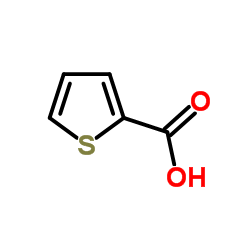Thiophene-2-carboxylic acid

Thiophene-2-carboxylic acid structure
|
Common Name | Thiophene-2-carboxylic acid | ||
|---|---|---|---|---|
| CAS Number | 527-72-0 | Molecular Weight | 128.149 | |
| Density | 1.4±0.1 g/cm3 | Boiling Point | 260.0±0.0 °C at 760 mmHg | |
| Molecular Formula | C5H4O2S | Melting Point | 125-127 °C(lit.) | |
| MSDS | Chinese USA | Flash Point | 117.8±19.8 °C | |
|
Drug-loaded gold/iron/gold plasmonic nanoparticles for magnetic targeted chemo-photothermal treatment of rheumatoid arthritis.
Biomaterials 61 , 95-102, (2015) We have developed methotrexate (MTX)-loaded poly(lactic-co-glycolic acid, PLGA) gold (Au)/iron (Fe)/gold (Au) half-shell nanoparticles conjugated with arginine-glycine-aspartic acid (RGD), which can be applied for magnetic targeted chemo-photothermal treatmen... |
|
|
Comparative in vitro anti-hepatitis C virus activities of a selected series of polymerase, protease, and helicase inhibitors.
Antimicrob. Agents Chemother. 52 , 3433-7, (2008) We report here a comparative study of the anti-hepatitis C virus (HCV) activities of selected (i) nucleoside polymerase, (ii) nonnucleoside polymerase, (iii) alpha,gamma-diketo acid polymerase, (iv) NS3 protease, and (v) helicase inhibitors, as well as (vi) c... |
|
|
Carbon dioxide utilization via carbonate-promoted C-H carboxylation.
Nature 531 , 215-9, (2016) Using carbon dioxide (CO2) as a feedstock for commodity synthesis is an attractive means of reducing greenhouse gas emissions and a possible stepping-stone towards renewable synthetic fuels. A major impediment to synthesizing compounds from CO2 is the difficu... |
|
|
Discovery of thiophene-2-carboxylic acids as potent inhibitors of HCV NS5B polymerase and HCV subgenomic RNA replication. Part 1: Sulfonamides.
Bioorg. Med. Chem. Lett. 14(3) , 793-6, (2004) The discovery of a novel class of HCV NS5B polymerase inhibitors, 3-arylsulfonylamino-5-phenyl-thiophene-2-carboxylic acids is described. SAR studies have yielded several potent inhibitors of HCV polymerase as well as of HCV subgenomic RNA replication in Huh-... |
|
|
In search of oligo(2-thienyl)-substituted pyridine derivatives: a modular approach to di-, tri- and tetra(2-thienyl)pyridines.
Chemistry 17(42) , 11838-43, (2011) Herein, we describe our attempts to systematically prepare a series of oligo(2-thienyl)-substituted pyridine derivatives. The crucial starting material, a β-alkoxy-β-ketoenamide, is easily available on a large scale by the reaction of lithiated methoxyallene ... |
|
|
Degradation of thiophene-2-carboxylate, furan-2-carboxylate, pyrrole-2-carboxylate and other thiophene derivatives by the bacterium Vibrio YC1.
Appl. Microbiol. Biotechnol. 32(6) , 715-20, (1990) A bacterium of the genus Vibrio, capable of degrading thiophene derivatives, was isolated from enrichment cultures inoculated with oil-contaminated estuarine mud. Of the thiophene derivatives tested, only thiophene-2-carboxylate (T2C), thiophene-2-acetate and... |
|
|
[Double blind study of the mucoregulating action of sodium thiophene carboxylate (author's transl)].
Sem. Hop. 57(5-6) , 307-10, (1981) A double blind study of thiophene carboxylate in 32 chronic bronchitis patients, show an improvement of clinical and respiratory condition in the treated group. However, there is no increase in volume of expectoration and no fluidizing. The product acts as mu... |
|
|
Sodium thiophene carboxylate does not facilitate expectoration.
Eur. Respir. J. 4(6) , 718-22, (1991) A randomised double-blind crossover study compared the clinical effectiveness of a 21-day treatment with 600 mg per day of sodium thiophene carboxylate and placebo in 33 patients with stable chronic bronchial disease. During the seven week trial, subjective s... |
|
|
Thionapthene-2-carboxylic acid: a new antihypercalcemic agent.
Endocrinology 117(4) , 1508-11, (1985) Thiophene-2-carboxylic acid (TCA) was previously shown to be hypocalcemic in the rat. We have compared TCA with thionapthene-2-carboxylic acid (TNCA), an analog which is a more potent inhibitor of bone resorption in vitro, for the ability to decrease serum ca... |
|
|
Differential reactivity of thiophene-2-carboxylic and thiophene-3-carboxylic acids: Results from DFT and Hartree-Fock theory.
J. Mol. Graph. Model. 28(6) , 540-7, (2010) In the course of investigating the propensity of aromatic acids to react with selected nucleophiles, we came across an interesting difference in yields for two structurally similar thiophene carboxylic acids. Given that these yields were consistent across mor... |